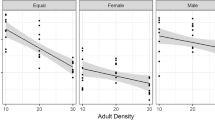Summary
The effects of egg cannibalism, conditioned medium and the presence of quinone secretions on oviposition rate were studied using single pairs of adults to eliminate any direct crowding effects. Most measurements were made on beetles confined to the surface of the flour medium in plastic towers. Oviposition rate was decreased by about 58% when pairs were transferred from fresh to conditioned medium; lowered about 25% when only quinones were present and the medium was still fresh; and enhanced 35% in dry conditions when beetles were provided with eggs to eat. Both the lowered oviposition rate in confined cultures and egg-eating may be explained by natural selection at the individual level. Cannibalizing eggs boosts a female's oviposition rate. The presence of quinones or conditioned medium indicates high population densities and acts as a signal for ceasing oviposition and dispersing to avoid high egg mortality. In confined populations, this results in population regulation, while in open populations, this strategy is a mechanism to avoid competition. It implies that the resource shortages normally experienced by such organisms are relative, not absolute.
Similar content being viewed by others
References
Andrewartha, H. G. (1961)Introduction to the Study of Animal Populations. Univ. of Chicago Press, Chicago.
Askew, R. R. (1971)Parasitic Insects. American Elsevier, New York.
Boyer, J. F. (1976) The effects of prior environments onTribolium castaneum.J. Anim. Ecol. 45: 865–874.
Brereton, J. Le Gay. (1962) Evolved regulatory mechanisms of population control. 81–93. In G. W. Leeper (ed).The Evolution of Living Organisms. Melbourne Univ. Press, Melbourne.
Crombie, A. C. (1947) Interspecific competition.J. Anim. Ecol.,16: 44–73.
Dawson, P. S. (1968) Xenocide, suicide and cannibalism in flour beetlesAm. Nat. 102: 97–105.
Dawson, P. S. (1977) Life history strategy and evolutionary history ofTribolium flour beetles.Evolution 31: 226–229.
Faustini, D. L. and W. E. Burkholder (1987) Quinone-aggregation pheromone interaction in the red flour beetle.Anim. Behav. 35: 601–603.
Ghent, A. W. (1963) Studies of behavior of theTribolium flour beetles. I. Contrasting responses ofT. castaneum andT. confusum to fresh and conditioned flours.Ecology 44: 269–283.
Ho, F. K. and P. S. Dawson (1966) Egg cannibalism byTribolium larvae.Ecology 47: 318–322.
Holdaway, F. G. (1932) An experimental study of the growth of populations of the “flour beetle”Tribolium confusum Duval, as affected by atmospheric moisture.Ecol. Monog. 2: 261–304.
Ito, M. (1956) The relation between the oviposition of the rust-red flour beetleTribolium castaneum Herbst and its burrowing of entrance into flour.Res. Popul. Ecol. 3: 26.
Katsoyannos, B. I. (1975) Oviposition-deterring, male-arresting, fruit-marking pheromone inRhagoletis cerasi.Environ. Entomol. 4: 801–807.
Lack, D. (1954) The evolution of reproductive rates. 143–156. In J. S. Huxley, A. C. Hardy and E. B. Ford (eds)Evolution as a process. Allen and Unwin, London.
Lavie, B. and U. Ritte. (1980) Correlated effects of the response to conditioned medium in the flour beetle,Tribolium castaneum.Res. Popul. Ecol. 21: 228–232.
Leconti, J. D. and L. M. Roth (1953) Composition of the odorous secretion ofTribolium castaneum.Ann. Ent. Soc. Amer. 46: 281–289.
Lloyd, M. (1961) Artificial production of “pink” flour.Tribolium Information Bulletin 4: 22–24.
Lomnicki, A. and J. Krawczyk (1980) Equal egg densities as a result of emigration inTribolium castaneum.Ecology 61: 432–434.
Mertz, D. B. (1971) Life history phenomena in increasing and decreasing populations. 361–399. In G. P. Patil, E. C. Pielou and W. E. Waters, (eds)Statistical Ecology. Volume II. Sampling and Modeling Biological Populations and Population Dynamics. The Penn State Univ. Press, University Park.
Mertz, D. B. and J. R. Robertson (1970) Some developmental consequences of handling, egg-eating, and population density for flour beetle larvae.Ecology 51: 989–998.
Naylor, A. F. (1961) Dispersal in the red flour beetleTribolium castaneum (Tenebrionidae).Ecology 42: 231–237.
Ogden, J. C. (1969) Effect of components of conditioned medium on behavior inTribolium confusum.Physiol. Zool. 42: 266–274.
Ogden, J. C. (1970) Aspects of dispersal inTribolium flour beetles.Phyziol. Zool.,43: 124–131.
Park, T. (1948) Experimental studies of interspecies competition. I. Competition between populations of the flour beetles,Tribolium confusum Duval andTribolium castaneum Herbst.Ecol. Monog. 18: 265–308.
Rich, E. (1956) Egg cannibalism and fecundity inTribolium.Ecology 37: 109–120.
Roitberg, B. D. and R. J. Prokopy (1989) Insects that Mark Host Plants.Bioscience 37: 400–406.
Sokal, R. R. and F. J. Rohlf (1969)Biometry. W. H. Freeman and Co. San Francisco.
Sokoloff, A. (1966)The Genetics of Tribolium and Related Species. Academic Press, New York.
Sokoloff, A., I. M. Lerner and F. K. Ho (1965) Self-elimination ofTribolium castaneum following xenocide ofT. confusum.Am. Nat. 49: 400–404.
Sonleitner, F. J., (1961) Factors affecting egg cannibalism and fecundity in populations of adultTribolium castaneum Herbst.Physiol. Zool. 34: 233–255.
Sonleitner, F. J. (1962) Evolution of the population regulation mechanism inTribolium castaneum Herbst (abstract).Bull. Ecol. Soc. Amer. 43: 87.
Sonleitner, F. J. (1978) Longevity and oviposition rate inTribolium castaneum; Rubner's hypothesis and natural selection.Tribolium Information Bulletin.21: 150–154.
Stanley, J. (1938) The egg-producing capacity of populations ofTribolium confusum Duv. as affected by intensive cannibalistic egg-consumption.Can. J. Res. 16: 300–306.
Yoshida, T. (1961) Oviposition behaviors of two species of bean weevils and interspecific competition between them.Mem. Fac. Lib. Arts, Educ. and Nat. Sci., Miyazaki Univ. 11: 41–65.
Ziegler, J. R. (1976) Evolution of the migration response: emigration byTribolium and the influence of age.Evolution 30: 579–592.
Author information
Authors and Affiliations
Rights and permissions
About this article
Cite this article
Sonleitner, F.J., Gutherie, J. Factors affecting oviposition rate in the flour beetleTribolium castaneum and the origin of the population regulation mechanism. Res Popul Ecol 33, 1–11 (1991). https://doi.org/10.1007/BF02514569
Issue Date:
DOI: https://doi.org/10.1007/BF02514569




